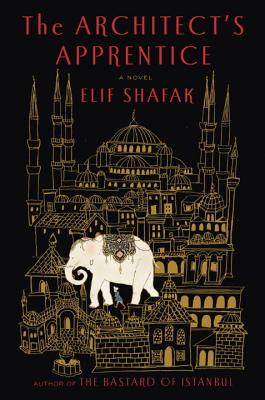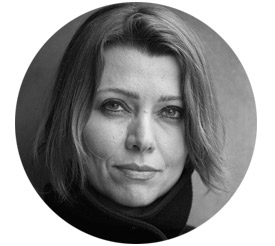 The Architect’s Apprentice
The Architect’s Apprentice
by Elif Shafak
Viking, 2014; 432pp
In a world of inter-religious conflict, plague, and natural disasters, the most elegant teleology may be found in architecture. This is Elif Shafak‘s proposition in her ambitious new novel, The Architect’s Apprentice. Shafak is the mostly widely read female writer in Turkey, has 1.7 million Twitter followers, and in 2010 she was made a chevalier of the Ordre des Arts et des Lettres. She writes regularly for the Guardian on feminism, human rights, and the state of democracy in Turkey. Although The Architect’s Apprentice is a historical novel, set mostly in the sixteenth century in Istanbul, its author’s very contemporary concerns flow through it.
Inspired by an image in Gulru Necipoglu’s The Age of Sinan: Architectural Culture in the Ottoman Empire, Shafak sets out to imagine the world and the people outside the frame of official history. As she describes it in her author’s note:
it was a painting of Sultan Suleiman, tall and sleek in his kaftan. But it was the figures in the background that intrigued me. There was an elephant and a mahout [elephant tamer] in front of the Suleimaniye Mosque; they were hovering on the edge of the picture, as if ready to run away, unsure as to what they were doing in the same frame as the Sultan and the monument dedicated to him.
The mahout becomes our hero, Jahan, an Indian boy we first meet when he is twelve years old and new to Istanbul. The elephant is Chota, “the tiniest elephant in the empire” and “white as boiled rice,” his best friend and ward. Jahan is an invention of Shafak’s; his master, the Chief Royal Architect, Mimar Sinan, is not. Nor are the sultans who come and go through Jahan’s story: Sultan Suleiman the Magnificent; Sultan Selim; Sultan Murad. But it’s characters marginal to the official history that interest Shafak, and we spend most of the novel in their company. Along the way, we meet concubines and thieves, sailors and gypsies, and the seraglio’s other animal tamers. Through Jahan, we also understand the impossibilities of life for the women of the sultan’s palace — even for Suleiman’s own daughter, Mihrimah, whom Jahan falls in love with. Sixteenth-century Istanbul is a brutal world, and the novel’s body count is high even if it shies away from some of the uglier details.
Jahan proves his worth to Sinan during the construction of a bridge over the River Pruth, as the Ottoman army makes its way to fight the Franks. Thereafter, he is adopted as an apprentice. Sinan, seen through Jahan’s eyes, is a somewhat mystical presence. His experiences under Suleiman and his knowledge of architecture both within and outside the Ottoman Empire have made him stoical and pragmatic, philosophical and wise. Halfway through the novel, Jahan comes to realise that “his master’s secret resided not in his toughness, for he was not tough, nor in his indestructibility, for he was not indestructible, but in his ability to adapt to change and calamity, and to rebuild himself, again and again, out of the ruins.” Sinan understands the importance of thought before action, as when he tells the sultan on the banks of the Pruth, “My Lord, the others, with pure intentions no doubt, began the construction straight away. I shall build the bridge in my mind. Only after that will I have it set in stone.” Architecture has given him a ruling metaphor for life; it is Shafak’s, too.
One might recall, in this use of architecture as metaphor, the soliloquy of Hamlet’s in which his accidie is undercut by his wonder at “this most excellent canopy, the air, look you, this brave o’erhanging firmament, this majestical roof fretted with golden fire…” A similar kind of transcendental elision, between sky and roof, occurs many times in Shafak’s novel. Jahan’s epiphany on first seeing the completed Suleimaniye Mosque, for instance:
The dome had blended with the firmament above. […] Alone in the mosque, only a dot in this vast expanse, Jahan could think only of the world as an enormous building site. While the master and the apprentices had been raising this mosque, the universe had been constructing their fate. Never before had he thought of God as an architect. Christians, Jews, Muslims, Zoroastrians and people of myriad faiths and creeds lived under the same invisible dome. For the eye that could see, architecture was everywhere.
And indeed so it proves. Sinan refers to “the palace of our body” as he argues the worth of all people (“even a beggar owns a palace”). Jahan recognises in himself a dark side that he thinks of as “a secret cellar under the house of his soul.” The Chief Royal Astronomer’s interest in anatomy is explained away on the grounds that “God had designed the small cosmos and the big cosmos in parallel.” The microcosmic and the macrocosmic rhyme in Sinan’s teleology; order, harmony, and peace are accessible through the recognition of these natural patterns and echoes.
Of course, architecture is also a tool of the grand narrative of empire and dynasties. At one point, Sultan Selim demands that the dome of a newly commissioned mosque be larger than that of the Hagia Sophia to prove Islam’s dominance over Christianity. In his design, Sinan designs a mosque with a larger dome but with a floor to ceiling height that is lower than the Hagia Sophia’s — “Higher and lower simultaneously.” In so doing, he maintains the dignity of both religions. Even Sinan, though, cannot protect everyone, and the destruction of the hovels around the Hagia Sophia during renovation works occasions some painful scenes. As one of the other apprentices would later point out, the architectural and the political are far from inseparable:
“Every colossal mosque we built was raised thanks to the revenues from another conquest. On their way to the battleground the army would raze villages to the ground, kill more of my people. Our master never cared for these sorrows. He refused to see that, without bloodshed elsewhere, there would be no money, and without money there would be no building in the capital.”
But such is the complexity and beauty of Shafak’s construction that even this powerful and persuasive critique finds a counter in Sinan’s philosophy. In each of his designs, he embeds, invisible to the casual observer, a deliberate imperfection (for only God may be perfect); and in an economy built on terror and warfare, there are bloodstains even on the brickwork of sacred buildings. Is this not that structural imperfection writ large? Today we venerate old buildings despite the human cost of their construction — or indeed what they represent, historically — because they represent, in their ambition, their scale, and their skyward reach a desire for harmony and divinity. Architecture pictures humankind’s constant straining for perfection. It aspires. Reading Shafak’s rich, compassionate novel, we aspire too.
Elif Shafak will appear at our next Seriously Entertaining show, One Simple Rule, on April 21 at City Winery NYC. You can buy tickets here.
Follow Elif Shafak on Twitter:





